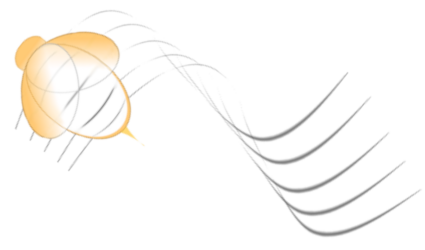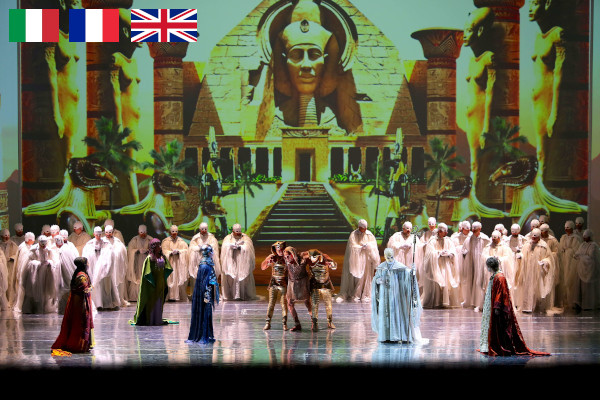I colori, e nient'altro
Spettacolare, anche se non entusiasmante, l'Aida al Carlo Felice di Genova. Si apprezza Maria Teresa Leva nei panni della protagonista.
Leggi anche la recensione del cast con Vassileva, Kutasi, Berti: Aida, 09/12/2018
GENOVA, 15 dicembre 2018 - Aida et Radamès sono fra le grandi coppie tragiche dell'opera, la loro storia parla d'amore e di colpa, di tradimento e gelosia. Questa sera è narrata al Teatro Carlo Felice di Genova. La messa in scena di Alfonso Antoniozzi è soprattutto basata sull'effetto delle videografie di Monica Manganelli. Di volta in volta scenografie o liberi effetti di luce, mostrano architetture vagamente egiziane, paesaggi desertici che fanno pensare alla saga di Dune, portali, scalinate o anche figure astratte, raggi di luce danzanti, esplosivi, sempre legati alla musica, pieni di colori, evocativi. Siamo un tantino sorpresi dai prigionieri etiopi: Aida e il padre, il re Amonasro, sono certamente nobili quanto gli egiziani, allora perché i loro guerrieri devono sembrare usciti da un qualche sogno colonialista? Perizomi, pitture tribali in viso, lance... E perché i danzatori, con una coreografia peraltro assai noiosa, dovrebbero portare costumi che simulano nudità? Gli costumi sono piuttosto belli, soprattutto quello di Aida, ampio e morbido nei suoi toni caldi del giallo e del rosso, e quelli verde invidia di Amneris. Amneris è questa sera Alessandra Volpe, che rivela la sua voca solamente a partire dal terzo atto, quando si libera del suo vibrato eccessivo. Maria Teresa Leva è un'Aida toccante e convincente fin dall'inizio, dagli acuti dolci e delicati, dai pianissimo pieni di forza. Amadi Lagha è un Radamès credibile, con la sua voce tenorile piena e rotonda, dai suoni talora un po' forzati. Sergio Bologna nei panni di Amonasro ruba del tutto la scena a Ramfis, alias Fabrizio Beggi. Abbiamo un baritono forte e coinvolgente, con una presenza scenica intrigante, mentre Ramfis ha l'aria di essere uscito da Star Wars, e tutta quella pittura bianca sembra avergli influenzato la voce.
Andrea Battistoni dirige con molta energia, esagerando talora i ritmi di marcia, già ben scanditi in Verdi.
Notiamo qualche dettaglio tecnico: i sovratitoli appaiono qualche volta in ritardo, lo schermo video resta bianco per un momento.
Insomma, una produzione interessante, che viene salutata con applausi calorosi.
foto Marcello Orselli
Multicolore sans plus
par Suzanne Daumann
Étonnante, intéressante, mȇme si non excitante, Aida au Teatro Carlo Felice à Gȇnes. On apprecie Maria Teresa Leva, protagoniste touchante et convaincante.
Gȇnes, le 15 décembre 2018 - Aida et Radamès sont parmi les grands couples tragiques de l’opéra, leur histoire parle d’amour et de culpabilité, de trahison et de jalousie. Ce soir, elle est narrée par un groupe d’artistes du Teatro Carlo Felice à Gȇnes. La mise en scène d’Alfonso Antoniozzi est surtout basée sur les vidéographies étonnantes de Monica Manganelli. Tour à tour scénographie et effets lumière libres, elles montrent des architectures vaguement égyptiennes, des paysages désertiques qui font penser à la série de Dune, des portails et des escaliers, ou bien des figures abstraites, rayons de lumière dansantes, explosantes, toujours portés par la musique, pleins de couleurs, et évocateurs. Nous étions quelque peu surpris par l’aspect des prisonniers éthiopiens: Aida et son père, le roi éthiopien Amonasro, sont certainement d’une gent aussi noble que les Égyptiens, alors pourquoi leurs guerriers doivent-ils ressembler à quelque chose qui serait sorti d’un rȇve colonialiste? Pagnes, peintures faciales tribales, lances… Et pourquoi les danseurs qui dansaient la scène de ballet, d’une chorégraphie fort ennuyeuse d’ailleurs, doivent-ils porter des costumes de nus? Les autres costumes sont plutôt jolis, surtout la robe d’Aida, ample et coulante dans des jaunes et rouges chauds, et les robes vert-jalousie d’Amneris. Amneris est chantée ce soir par Alessandra Volpe, qui révèle sa voix seulement à partir de l’Acte III, quand elle se débarrasse de son vibrato excessif. Maria Teresa Leva est une Aida touchante et convaincante dès le début, aux aigus doux et subtiles, et aux pianissimos pleins de force. Amadi Lagha est un Radamès crédible, avec une voix de ténor pleine et ronde, aux sons parfois un peu forcés. Sergio Bologna dans le rôle d’Amonasro vole carrément la scène à Ramfis alias Fabrizio Beggi. Il a un baryton chaleureux et fort, et une présence scénique malicieuse, alors que Ramfis a l’air de quelque chose sorti de Star Wars, et toute cette peinture blanche a peut-ȇtre affecté sa voix.
Andrea Battistoni dirige avec beaucoup d’énergie, exagérant parfois les rhythmes de marche, déjà bien lourds chez Verdi.
Notons quelques détails techniques: les sous-titres apparaissent parfois trop tard, et l’écran vidéo reste blanc pendant un moment.
En somme, une production intéressante qui est saluée avec des applaudissements chaleureux.
foto Marcello Orselli
Colorful and not much else
by Suzanne Daumann
Amazing, intersting, but not thrilling Aida at Teatro Carlo Fenice in Genoa. Maria Teresa Leva is a moving and convincing Ethiopian princess
Genoa, December 15th, 2018 - Aida and Radames are among the great tragical couples of opera, their story is one of love and guilt, of treason and jealousy. It was told tonight by the team of artists from Teatro Carlo Fenice in Genoa. Alfonso Antoniozzi’s shoddy staging was saved by the amazing videographics by Monica Manganelli. Turn by turn scenography and freely roaming light effects, they showed Egypt-inspired architectures, bleak sandscapes that made us think of the Dune series, gates and stairways, or else abstract figures, rays of light dancing, exploding, always in tune as it were to the music, colorful and evocative. We were puzzled by the attire of the Ethiopian prisoners: Aida and her father, Ethiopian king Amonasro, are certainly of a race as noble as the Egyptians, why then did their warriors have to look like something out of every colonialist’s dream? Loincloths, tribal face paint, spears… And why did the dancers that perform the ballet scenes - and the choreography was so boring that it was nothing short of torture - have to wear nude suits? The other costumes were quite beautiful and characterizing, especially Aida’s flowing gown, in orange and reds, and Amneris’ jealousy-green dresses. Amneris was sung tonight by Alessandra Volpe, who revealed her voice only in Act III, when she dropped some of her obnoxious vibrato. Maria Teresa Leva’s Aida was moving and convincing from the start. Her high notes were subtle and sweet, and her pianissimi still held power. Amadi Lagha was a creditable Radames, with a full and round tenor voice, however sounding somewhat strained at times. It was Sergio Bologna in the role of Amonasro who stole the scene from Fabrizio Beggi’s Ramfis. He has a powerful warm baritone, and a strong stage presence whereas Ramfis looked like something out of Star Wars, and maybe all that white paint affected his voice.
Andrea Battistoni conducted with energy, sometimes overemphasizing the already heavy treading march rhythms of Verdi’s music.
A few technical details should be noted as well: the subtitles sometimes were not synchronized to the stage events, and the video screen went blank at one point.
An interesting show on the whole, that was greeted with much applause.
foto Marcello Orselli








